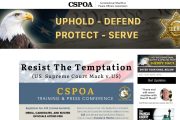
The Tenth Amendment Center (TAC) has issued its annual 2019-2020 report on the State of the Nullification Movement, a report of 108 pages, covering the definition, origins, historical uses, and modern applications of an idea developed by Thomas Jefferson and James Madison in the 1798 Kentucky and Virginia Resolutions in reaction to the unconstitutional Sedition Act of 1798.
The question that Jefferson and Madison struggled with in 1798, when they first proposed the doctrine of nullification, was what can a state do if the federal government asserts power the Constitution does not give it over a state government? One alternative was obviously secession (separating from the Union, and establishing a separate nation — it’s historical ignorance to conflate secession and nullification). Jefferson and Madison did not want to secede from the Union, but rather coerce the U.S. government to follow the Constitution of the United States by the doctrine of nullification.
In the situation confronting these two great Founders, Congress, under the control of the Federalist Party, had passed the Sedition Act, which abridged freedom of speech and press, a mere seven years after the First Amendment specifically forbade Congress from passing such a law. Federalist judges compliantly handed down fines and jail sentences for those who violated the law, despite it being a clear violation of the First Amendment.
What TAC attempts to do nowadays is take the principles crafted by Jefferson and Madison and apply them to nullifying contemporary usurpations by the federal government of the powers of the states and the rights of its citizens. “In many ways, today’s federal government has effectively suspended the legislative power of the states by assuming powers never delegated to it in the Constitution.”
TAC laments that efforts to combat this problem at the ballot box have not worked well. And since “voting the bums out” usually results in the election of just more “bums,” TAC offers the concept of nullification to rein in the federal government. TAC cautions, “We won’t roll it back in a year,” and they note that Jefferson and Madison realized that, too. Their nullification solution was not solely, or even primarily a tool for just dealing with the Sedition Act, but was about constructing “a framework for future action.”
“At the TAC, we always keep the Constitution and liberty as our core objective. But we must also recognize that it will take a series of small victories to reach our ultimate goal.”
To that end, TAC notes that there are two types of nullification that can be utilized in the fight to roll back the federal behemoth. One is to make a federal action “legally null and void” by state legislative action, for example, and a second way is to make the federal action of no value or consequence. “The law remains on the books, but it can’t be practically enforced.”
One historical usage of the doctrine of nullification was when Michigan and Wisconsin used nullification to thwart the Fugitive Slave Act in the 1850s. Local officials refused to cooperate with the federal officials in putting runaway slaves back into bondage. Two prominent abolitionists — John Greenleaf Whittier and William Lloyd Garrison — explicitly said they were using the doctrine of nullification to combat slavery.
Some modern examples of the use of nullification in the paper include the promotion of sound money, combatting illegal government surveillance and civil asset forfeiture, legalizing marijuana, expanding food freedom and overriding the FDA, protecting the right to keep and bear arms, and defending statess authority over the National Guard.
For example, TAC quotes a Mises Institute study by Professor William Green, arguing that if multiple states would recognize gold and silver as legal tender, as Utah did in 2011, citing Article I, Section 10 of the U.S. Constitution, “it would effectively end the federal government’s monopoly on money.”
To undercut the use of nullification in our day, opponents of nullification always bring up South Carolina’s John C. Calhoun and the tariff crisis of the late 1820s and early 1830s. “Given the way the media and academics talk about nullification, you would almost think Calhoun came up with the concept himself. Because Calhoun was a vocal proponent of slavery, nullification opponents play this game to the hilt, inferring, and sometimes outright asserting, that the whole idea is rooted in racism.”
But it was not. Madison said that the whole idea of nullification was “refusal to cooperate with officers of the Union,” thus forcing either the outright repeal of a law, or the abandonment of any effort to enforce it.
The use of nullification has become more importent the ever. In 2013, the National Governors’ Association asserted that states are “partners” with the federal government in implementing most of the policies of the federal government. In other words, TAC argues, the states are now cooperating in the loss of their powers. If citizens do not want the federal government taking away more and more of their states’ powers, they need to put heavy pressure on state legislators to nullify illegal federal policies.
TAC does not promise an overnight victory by using nullification, as they say they are playing “the long game,” adding, “We won’t roll it back in a year.”
As the Chinese philosopher Laozi said, “A journey of a thousand miles begins with a single step.” Nullification is a good for several steps on the journey to the restoration of constitutional government.
Photo: stuartmiles99 / iStock / Getty Images Plus
Steve Byas is a university instructor in history and government and is the author of History’s Greatest Libels. He may be contacted at [email protected].



